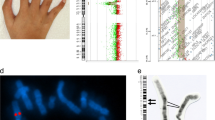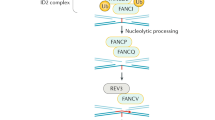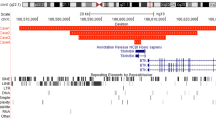Abstract
Diamond-Blackfan anaemia (DBA; MIM♯205900) is a rare disorder manifested as a pure red-cell aplasia in the neonatal period or in infancy1–3. The clinical hallmark of DBA is a selective decrease in erythroid precursors and anaemia. Other lineages are usually normal and the peripheral white blood cell count is normal. In approximately one-third of cases, the disease is associated with a wide variety of congenital anomalies and malformations3–7. Most cases are sporadic, but 10–20% of them follow a recessive or a dominant inheritance pattern5. A female with DBA and a chromosomal translocation involving chromosome 19q was recently identified8. We undertook a linkage analysis with chromosome 19 markers in multiplex DBA families of Swedish, French, Dutch, Arabic and Italian origin. Significant linkage to chromosome 19q13 was established for dominant and recessive inherited DBA with a peak lod score at D19S197 (Zmax=7.08, θ=0.00). Within this region, a submicroscopic de novo deletion of 3.3 Mb was identified in a patient with DBA. The deletion coincides with the translocation break-point and, together with key recombinations, restricts the DBA gene to a 1.8-Mb region. The results suggest that, despite its clinical heterogeneity, DBA is genetically homogeneous for a gene in 19q13.
This is a preview of subscription content, access via your institution
Access options
Subscribe to this journal
Receive 12 print issues and online access
$209.00 per year
only $17.42 per issue
Buy this article
- Purchase on Springer Link
- Instant access to full article PDF
Prices may be subject to local taxes which are calculated during checkout
Similar content being viewed by others
References
Diamond, L.K. & Blackfan, K.D. Hypoplastic anemia. Am. J. Dis. Child. 56, 464–467 (1938).
Alter, B.P. Childhood red cell aplasia. Am. J. Pediatr. Hematol. Oncol. 2, 121–139 (1980).
Halperin, D.S. & Freedman, M.H. Diamond-Blackfan anemia: etiology, pathophysiology, and treatment. Am. J. Pediatr. Hematol. Oncol. 11, 380–394 (1989).
Diamond, L.K., Wang, W.C. & Alter, B.P. Congenital hypoplastic anemia. Adv. Pediatr. 22, 349–378 (1976).
Young, N.S. & Alter, B.P., Acquired and Inherited (WB Saunders, Philadelphia, 1994).
Ball, S.E., McGuckin, C.P., Jenkins, G. & Gordon-Smith, B.C. Diamond-Blackfan anemia in the U .K.: analysis of 80 cases from a 20-year birth cohort. Br. J. Haematol. 94, 645–653 (1996).
Janov, A.J., Leong, T., Nathan, D.G. & Guinan, E.C. Diamond-Blackfan anemia. Natural history and sequelae of treatment. Medicine. 75, 77–87 (1996).
Gustavsson, P. et al. Diamond-Blackfan anemia in a girl with a de novo balanced reciprocal X; 19 translation. j Med. Genet. (in the press).
D'Avanzo, M., Pistoia, V., Santinelli, R., Corcione, A. & Canino, G. Heterogeneity of the erythroid defect in two cases of Aase- Smith syndrome. Pediatr. Hematol. Oncol. 11, 189–195 (1994).
Greinix, H.T. et al. Long-term survival and cure after marrow transplantation for congenital hypoplastic anaemia(Diamond-Blackfan syndrome). Br. J. Haematol. 84, 515–520 (1993).
Ashworth, L.K. et al. An integrated metric physical map of human chromosome 19. Nature Genet. 11, 422–27 (1995).
Mohrenweiser, H. et al. Report of the third international workshop on human chromosome 19 mapping 1996. Cytogenet Cell Genet. 74, 161–186 (1996).
Tassabehji, M. et al. Mutations in the PAX3 gene causing Waardenburg syndrome type 1 and type 2. Nature Genet. 3, 26–31 (1993).
Little, M. et al. DNA binding capacity of the WT1 protein is abolished by Denys-Drash syndrome WT1 point mutations. Hum. Mol. Genet. 4, 351–358 (1995).
Eber, S.F. et al. Ankyrin-1 mutations are a major cause of dominant and recessive hereditary spherocytosis. Nature Genet. 13, 214–218 (1996).
Glader, E.B. & Backer, K. Elevated red cell adenosine deaminase activity: a marker of disordered erythropoiesis in Diamond-Blackfan anaemia and other haematologic diseases. Br. J. Haematol. 68, 165–168 (1988).
Gojic, V., Korthof, E.T., Bosch, L.J., Puyn, W.H. & van, Haeringen A., Congenital hypoplastic anemia: another example of autosomal dominant transmission. Am. J. Med. Genet. 50, 87–89 (1994).
Pinkel, D., Straume, T. & Gray, J.W., Cytogenetic analysis using quantitative, high-sensitivity, fluorescence in situ hybridization. Proc. Natl. Acad. Sci. USA. 83, 2934–2938 (1986).
Lichter, P., Cremer, T., Borden, J., Manuelides, L. & Ward, D.C. Delineation of individual human chromosomes in metaphase and interphase cells by in situ suppression hybridization usfng recombinant DNA libraries. Hum. Genet. 80, 224–234 (1988).
Dib, C. et al. A comprehensive genetic map of the human genome based on 5,264 microsatellites. Nature 380, 152–154 (1996).
Cottingham, R.W. Jr., Idury, R.M. & Schaffer, A.A. Faster sequential genetic linkage computations. Am. J. Hum. Genet. 53, 252–263 (1993).
Lathrop, G.M. & Lalouel, J.M. Easy calculations of lod scores and genetic risks on smaller computers. Am. J. Hum. Genet. 3, 460–465 (1984).
Ott, J. Analysis of Human Genetic Linkage (Johns Hopkins University Press, Baltimore, 1991).
Author information
Authors and Affiliations
Corresponding author
Rights and permissions
About this article
Cite this article
Gustavsson, P., Willig, TN., Haeringen, A. et al. Diamond-Blackfan anaemia: genetic homogeneity for a gene on chromosome 19q13 restricted to 1.8 Mb. Nat Genet 16, 368–371 (1997). https://doi.org/10.1038/ng0897-368
Received:
Accepted:
Issue Date:
DOI: https://doi.org/10.1038/ng0897-368
This article is cited by
-
Perspectives of current understanding and therapeutics of Diamond-Blackfan anemia
Leukemia (2023)
-
Perspective on Diamond–Blackfan anemia: lessons from a rare congenital bone marrow failure syndrome
Leukemia (2018)
-
A de novo 1.6Mb microdeletion at 19q13.2 in a boy with Diamond-Blackfan anemia, global developmental delay and multiple congenital anomalies
Molecular Cytogenetics (2016)
-
Molecular pathogenesis in Diamond–Blackfan anemia
International Journal of Hematology (2010)
-
Hematopoietic stem cell transplantation for Diamond Blackfan anemia: a report from the Diamond Blackfan Anemia Registry
Bone Marrow Transplantation (2001)



